The topic of this article may not meet Wikipedia's general notability guideline .(May 2022) |

Sengoku: Chanbara Roleplaying in Feudal Japan is a role-playing game set in 16th-century Japan.
The topic of this article may not meet Wikipedia's general notability guideline .(May 2022) |

Sengoku: Chanbara Roleplaying in Feudal Japan is a role-playing game set in 16th-century Japan.
Sengoku comes as a single book. It uses the Fuzion rules system, [1] which is highly rated for flexibility but can be difficult to learn. There are detailed descriptions of society, weapons, language, locations and such, a comprehensive filmography, and quotations scattered throughout the book. The tone can be realistic, heroic as in Akira Kurosawa films, or super heroic as in many manga comic books.
Sengoku was created by Anthony J. Bryant and Mark Arsenault, [2] and published by Gold Rush Games in 1999.
A revised edition of Sengoku was published in 2002. [1]
The original version was reviewed in Knights of the Dinner Table Magazine #38.
The revised edition was nominated for the 2002 Grog d'Or Awards in the category Best RPG.[ citation needed ]
West End Games (WEG) was a company that made board, role-playing, and war games. It was founded by Daniel Scott Palter in 1974 in New York City, but later moved to Honesdale, Pennsylvania. Its product lines included Star Wars, Paranoia, Torg, DC Universe, and Junta.

The Monster Manual is the primary bestiary sourcebook for monsters in the Dungeons & Dragons fantasy role-playing game, first published in 1977 by TSR. The Monster Manual was the first hardcover D&D book and includes monsters derived from mythology and folklore, as well as creatures created specifically for D&D. Creature descriptions include game-specific statistics, a brief description of its habits and habitats, and typically an image of the creature. Along with the Player's Handbook and Dungeon Master's Guide, the Monster Manual is one of the three "core rulebooks" in most editions of the D&D game. As such, new editions of the Monster Manual have been released for each edition of D&D. Due to the level of detail and illustration included in the 1977 release, the book was cited as a pivotal example of a new style of wargame books. Future editions would draw on various sources and act as a compendium of published monsters.

Monster Manual II is the title shared by two hardback rulebooks published for different versions of the Dungeons & Dragons (D&D) fantasy roleplaying game.
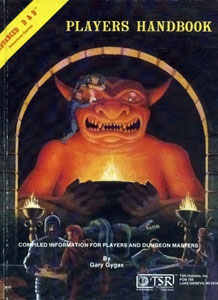
The Player's Handbook is the name given to one of the core rulebooks in every edition of the fantasy role-playing game Dungeons & Dragons (D&D). It does not contain the complete set of rules for the game, and only includes rules for use by players of the game. Additional rules, for use by Dungeon Masters (DMs), who referee the game, can be found in the Dungeon Master's Guide. Many optional rules, such as those governing extremely high-level players, and some of the more obscure spells, are found in other sources.
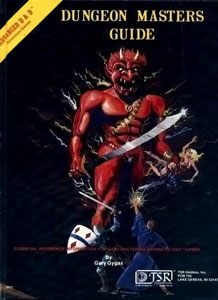
The Dungeon Master's Guide is a book of rules for the fantasy role-playing game Dungeons & Dragons. The Dungeon Master's Guide contains rules concerning the arbitration and administration of a game, and is intended for use by the game's Dungeon Master.

Deities & Demigods, alternatively known as Legends & Lore, is a reference book for the Dungeons & Dragons fantasy role-playing game (D&D). The book provides descriptions and game statistics of gods and legendary creatures from various sources in mythology and fiction, and allows dungeon masters to incorporate aspects of religions and mythos into their D&D campaigns.
Jeff Grubb is an author who writes novels, short stories, and comics and a computer and role-playing game designer in the fantasy genre. Grubb worked on the Dragonlance campaign setting under Tracy Hickman, and the Forgotten Realms setting with Ed Greenwood. His written works include The Finder's Stone Trilogy, the Spelljammer and Jakandor campaign settings, and contributions to Dragonlance and the computer game Guild Wars Nightfall (2006).
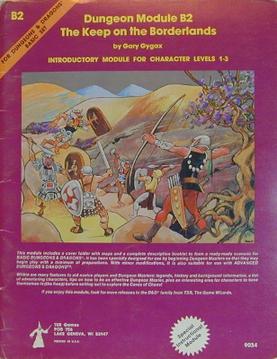
The Keep on the Borderlands is a Dungeons & Dragons adventure module by Gary Gygax, first printed in December 1979. In it, player characters are based at a keep and investigate a nearby series of caves that are filled with a variety of monsters. It was designed to be used with the Dungeons & Dragons Basic Set, and was included in the 1979–1982 editions of the Basic Set. It was designed for people new to Dungeons & Dragons.

The Manual of the Planes is a manual for the Dungeons and Dragons role-playing game. This text addresses the planar cosmology of the game universe.
An owlbear is a fictional creature originally created for the Dungeons & Dragons fantasy role-playing game. An owlbear is depicted as a cross between a bear and an owl, which "hugs" like a bear and attacks with its beak. Inspired by a plastic toy made in Hong Kong, Gary Gygax created the owlbear and introduced the creature to the game in the 1975 Greyhawk supplement; the creature has since appeared in every subsequent edition of the game. Owlbears, or similar beasts, also appear in several other fantasy role-playing games, video games and other media.

The Forgotten Realms Campaign Setting is a role-playing game sourcebook first published by TSR in 1987 for the first edition of the fantasy role-playing game Advanced Dungeons & Dragons that describes the campaign setting of the Forgotten Realms. It contains information on characters, locations and history. Various revised and updated editions have been produced over the years.

The Star Wars Roleplaying Game is a d20 System roleplaying game set in the Star Wars universe. The game was written by Bill Slavicsek, Andy Collins and J. D. Wiker and published by Wizards of the Coast in late 2000 and revised in 2002. In 2007, Wizards released the Saga Edition of the game, which made major changes in an effort to streamline the rules system.

Peter D. Adkison is an American game designer and businessman who is the founder and first CEO of Wizards of the Coast (1993–2001).
Anthony J. Bryant was an American author and editor.
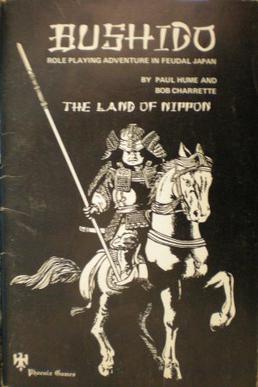
Bushido is a Samurai role-playing game set in Feudal Japan, originally designed by Robert N. Charrette and Paul R. Hume and published originally by Tyr Games, then Phoenix Games, and subsequently by Fantasy Games Unlimited. The setting for the game is a land called Nippon, and characters adventure in this heroic, mythic, and fantastic analogue of Japan's past.

Role-playing games made in Japan made their first appearance during the 1980s. Today, there are hundreds of Japanese-designed games as well as several translated games. Tabletop RPGs are referred to as tabletalk RPGs, a wasei-eigo term often shortened as TRPG in Japan to distinguish them from the video role-playing game genre.

The Psionics Handbook is a sourcebook published by Wizards of the Coast in 2001 for the 3rd edition of the Dungeons & Dragons fantasy role-playing game. It contains a multitude of rules and options for integrating psionic powers into the D&D game.
James Wallis is a British designer and publisher of tabletop and role-playing games.

Dark Tower is an adventure module published by Judges Guild in 1980 for the Advanced Dungeons & Dragons fantasy role-playing game.
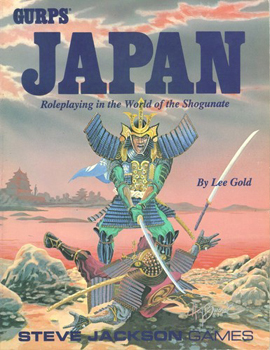
GURPS Japan, full title GURPS Japan: Roleplaying in the World of the Shogunate or GURPS Japan: Beauty, Terror, and Adventure, is a sourcebook for GURPS, a role-playing game by Steve Jackson Games. The first edition was published in 1988.